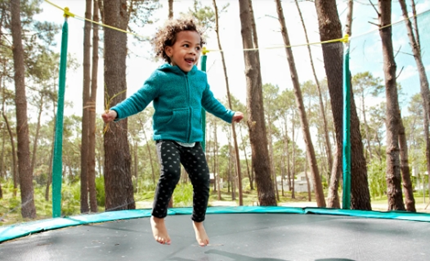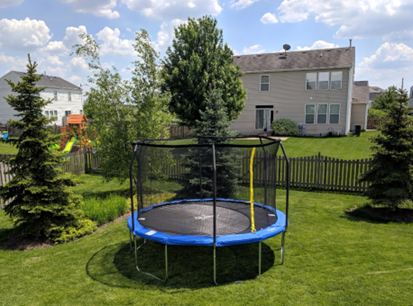Trampoline Durability: How Long Do Trampolines Last?
Trampolines are a beloved source of fun, exercise, and entertainment for families around the world. Whether used for fitness or recreation, they offer a dynamic way to stay active. However, like any other outdoor equipment, trampolines do not last forever. How long do trampolines last? Understanding the factors that influence a trampoline’s lifespan can help you maintain it properly and extend its usability. From the quality of materials used in construction to how often it's used, knowing what affects the durability of your trampoline is essential to ensuring it remains safe and functional for many years.

How Long Do Trampolines Last? Key Factors to Consider
Material Quality and Construction
The durability of a trampoline is heavily influenced by the materials used in its construction. Premium trampolines are made with high-quality materials such as galvanized steel frames, UV-resistant mats, and durable, rust-resistant springs. These materials ensure that the trampoline can withstand regular use and harsh weather conditions, extending its life. Cheaper models often utilize low-quality components that wear out more quickly, which may require frequent replacements. High-quality construction, including reinforced joints and durable stitching, contributes to the overall strength and longevity of the trampoline. Therefore, investing in a well-built trampoline is key to ensuring that it lasts for years.
Usage Frequency and User Weight
Another significant factor that influences how long a trampoline lasts is how often it is used and the weight of its users. Trampolines that are frequently used experience more wear and tear on the frame, springs, and mat. Additionally, trampolines have a maximum weight limit that should not be exceeded. Overloading the trampoline with excessive weight can cause damage to the springs, mat, and frame, leading to a shorter lifespan. Therefore, it's essential to follow the manufacturer’s guidelines for weight limits and usage recommendations. Limiting heavy use and adhering to proper weight restrictions helps prevent undue stress on the trampoline, prolonging its durability.
Environmental Exposure and Storage
The environment plays a crucial role in determining the lifespan of a trampoline. Trampolines exposed to the elements, such as sunlight, rain, and wind, are more likely to deteriorate over time. UV rays from the sun can break down the materials in the mat, causing it to weaken and lose its elasticity. Similarly, moisture can lead to rust and corrosion on the frame and springs, further decreasing the trampoline’s durability. To protect your trampoline, it’s vital to store it properly when not in use. Using a weather-resistant cover and moving the trampoline indoors during harsh weather conditions can help mitigate environmental damage and extend its life.
Signs Your Trampoline Is Reaching the End of Its Lifespan
Frayed or Torn Jumping Mat
The jumping mat is the most frequently used part of the trampoline, and over time, it is exposed to considerable wear. If you notice fraying edges or small tears in the mat, it may be a sign that it’s time for a replacement. A damaged mat can affect the trampoline’s overall performance and pose safety risks. It is essential to inspect the mat regularly for any signs of deterioration. A worn-out mat can compromise the trampoline’s bounce quality and make it unsafe to use. If the mat has visible damage, replacing it before further wear occurs is crucial to maintaining a safe jumping experience.
Rusted or Damaged Springs
Springs are vital for providing the bounce in a trampoline, and over time, they are susceptible to rust and wear. If the springs become corroded or show signs of visible damage, they may no longer provide a smooth and safe bounce. Rust can weaken the metal, causing the springs to lose their tension or even snap. This not only affects the quality of the bounce but also presents a serious safety hazard. Regularly inspect the springs for any signs of rust or damage, and replace them as necessary. Keeping the springs in good condition is essential for both performance and safety.
Weak or Bent Frame
The frame of the trampoline serves as its backbone, providing essential stability and support. Over time, heavy use or exposure to the elements can cause the frame to weaken or bend. A compromised frame may cause instability, making the trampoline unsafe to use. If the frame is bent or shows signs of structural damage, it’s crucial to address the issue immediately. A damaged frame can not only impact the safety of the trampoline but can also cause other components, such as the mat and springs, to wear out more quickly. Regularly inspect the frame for any signs of bending or damage to ensure the trampoline remains safe and stable.
How to Extend the Lifespan of Your Trampoline
Regular Maintenance and Inspections
Routine maintenance and inspections are essential for extending the lifespan of your trampoline. Regularly check the mat, springs, and frame for signs of wear, rust, or damage. Tighten any loose bolts and inspect the safety features to ensure they are properly secured. Keeping the trampoline clean and free of debris will also prevent damage and ensure safe use. Periodic maintenance helps identify minor issues before they escalate into major problems. Catching small wear and tear early can save you from costly repairs or replacements down the line. Always follow the manufacturer's maintenance guidelines for the best results.

Using a Trampoline Cover and Proper Storage
One of the most effective ways to prolong the life of your trampoline is to protect it from the elements. When not in use, cover the trampoline with a weather-resistant cover to shield it from UV rays, rain, and other environmental factors. If possible, store the trampoline indoors or in a sheltered area during the off-season or when extreme weather conditions are expected. Proper storage prevents exposure to harsh weather that can accelerate wear and tear. A cover helps protect the mat from UV degradation and the frame and springs from rust, ensuring that the trampoline stays in good condition for years.
Avoiding Overuse and Harsh Conditions
To ensure your trampoline lasts as long as possible, it's essential to avoid overuse and exposure to harsh conditions. Avoid exceeding the maximum weight limit set by the manufacturer, as this can place undue stress on the trampoline’s structure and lead to premature damage. Additionally, limit the number of users on the trampoline at any given time. Placing the trampoline in a shaded area helps reduce UV exposure, preventing the mat from deteriorating due to the sun’s rays. By using the trampoline responsibly, you can reduce the likelihood of damaging it and enjoy its benefits for many years.
Conclusion
In conclusion, the longevity of a trampoline depends on several factors, including the materials used, the frequency of use, and how well it is maintained. How long do trampolines last? By understanding the key factors that affect a trampoline’s lifespan and taking proactive steps to protect it, you can ensure that it remains a source of fun and fitness for many years. Regular inspections, proper storage, and responsible usage are essential for extending the life of your trampoline. With the right care, your trampoline can continue to provide a safe and enjoyable experience for you and your family.
FAQ
What is the average lifespan of a trampoline?
The average lifespan of a trampoline ranges from 3 to 8 years, depending on factors such as the quality of materials, frequency of use, and environmental conditions. Proper maintenance can help maximize its lifespan.
How can I protect my trampoline from weather damage?
Use a weather-resistant cover when not in use, and store the trampoline indoors during harsh weather or off-season periods. This helps prevent damage from UV rays, moisture, wind, and other elements.
Can a trampoline be used year-round in all climates?
While trampolines can be used year-round in moderate climates, extreme weather conditions can cause damage. It is advisable to store the trampoline indoors or use protective measures to prevent weather-related damage in harsh climates.








